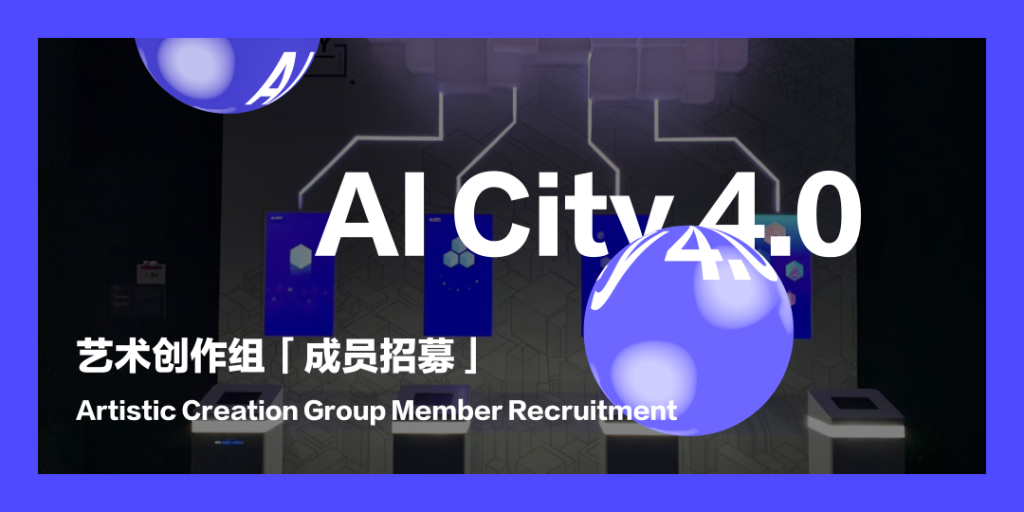
AI City 4.0
Artistic creation groupMember Recruitment
Artistic Creation Group
Member Recruitment
01 Project Background Background
The AI era is coming and predictable, and it is a major inflection point for human evolution. Artificial intelligence is also at the beginning of bringing greater value to human society, its potential is infinite, and our interaction with it has already begun. Modern network communication technology, mobile Internet, social media, perception technology, etc., make our life scenes and environment with the ability to sense, interact, feedback, and increasingly open. With the development trend of smart cities, the use of big data becomes more and more extensive: the integration of crowds and the Internet of Things forms a larger living system. Along with the intervention of new ICT technologies, the urban environment becomes more sensual, interactive, and flexible, allowing the integration of physical spaces and invisible networks to support human activities at all levels and to form a very complex ecosystem.
The Al City series of projects originated from the vision of the future city by Associate Professor Fu Zhiyong of the Department of Information Art and Design, School of Fine Arts, Tsinghua University. From the launch of the "Artificial Intelligence City" creation project in 2018 to the presentation of the virtual space experience version of Al City in 2021, the group explores the value of design from the perspective of design innovation and the concept of human-centeredness, and further considers what important role art and technology play in Design Futures in the context of society, humanity and technology. The aim is to explore the role of art and technology in the future of design. The project was awarded the Golden Dragonfly Award (Gold) at the China-Europe (Italy) Digital Exhibition for Creative Industries 2021, for the construction of a reflective urban interaction scenario of the future through the Design Futures approach, and for the creation of an artificially intelligent urban installation that integrates virtual and real.
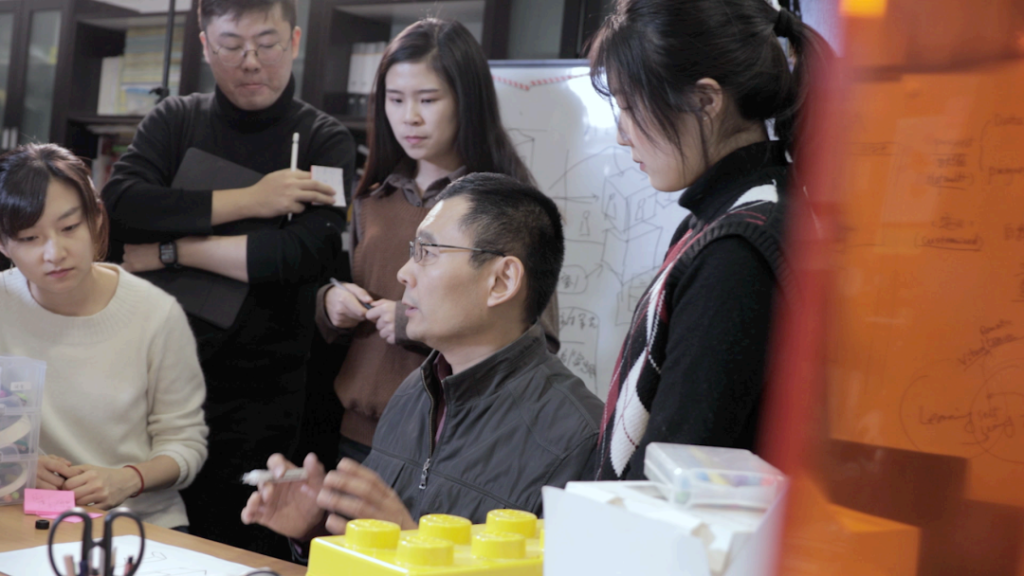
02 Development Iteration Development
- Al City 1.0 -
AI City 1.0, the first physical version, was presented in the 5th International Exhibition of Art and Science, organized by the National Museum of China and Tsinghua University, and hosted by Tsinghua University's School of Fine Arts and Tsinghua University's Art and Science Research Center. In this exhibition, Fu Zhiyong's Al City is presented as a set of interactive display installations with the theme of future artificial intelligence city development. The work explores the direction and reflection of the deep integration of AI and cities. Through several modules, such as Al City Brain, Future Co-creation, City Access, Future Mobility and Future Life, the work shows the social form, organization mode, urban structure and living scenario of the future AI city. According to the exhibition space of this work, the overall shape of Al City is adjusted from a distributed space to a wall where the audience can select and control through four touch screens, and the related contents are presented in 2.5D animation through the display screen. With the change of information, the brain also shows different colors.
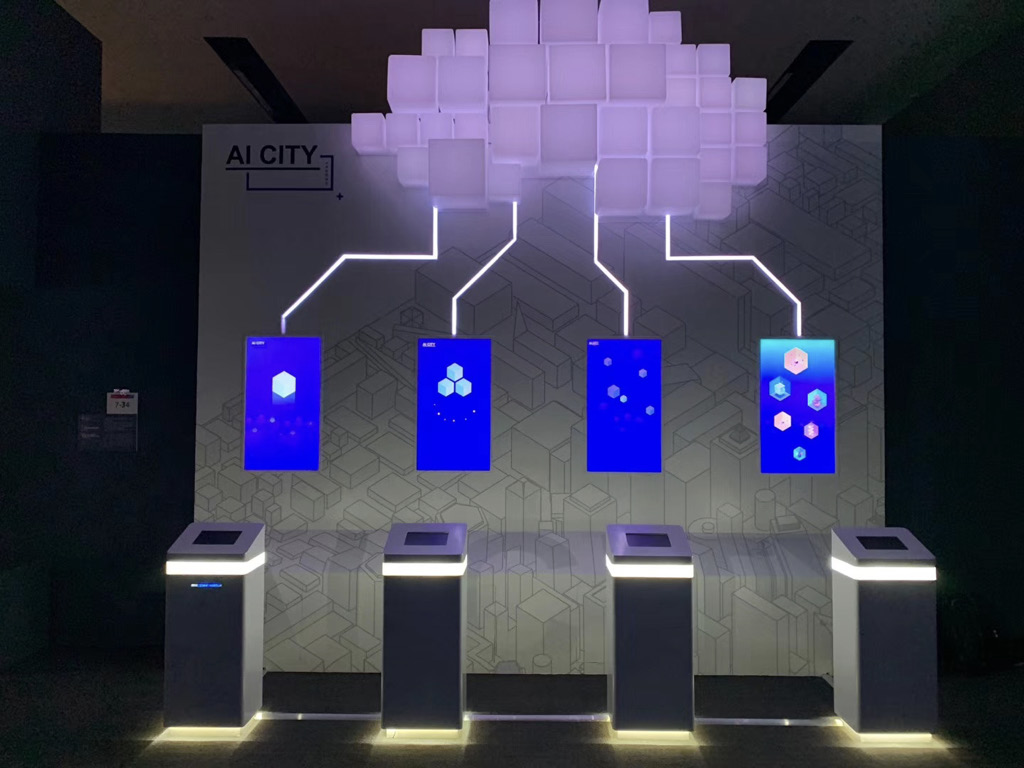
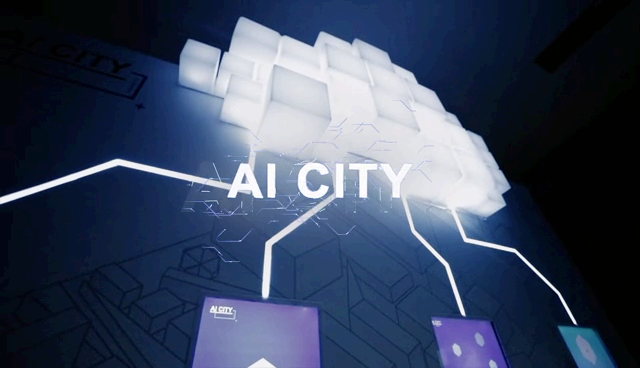
The 5th International Exhibition of Art and Science Works
- Al City 2.0 -
In Al City 2.0, the team showcases the possibilities of interaction in the 5G era, with a redesigned installation that takes the form of a central gathering where the audience can interact from all four sides. In the City Interface module viewers can choose from four models of future city development: the Dwelling module is a distributed virtual interconnected independent space that shows the future habitat patterns and existential anxieties of the city's inhabitants; the Transmission module connects the city's past, future, derivation and convergence trends; and the Co-creation module provides a participatory mapping of the future.
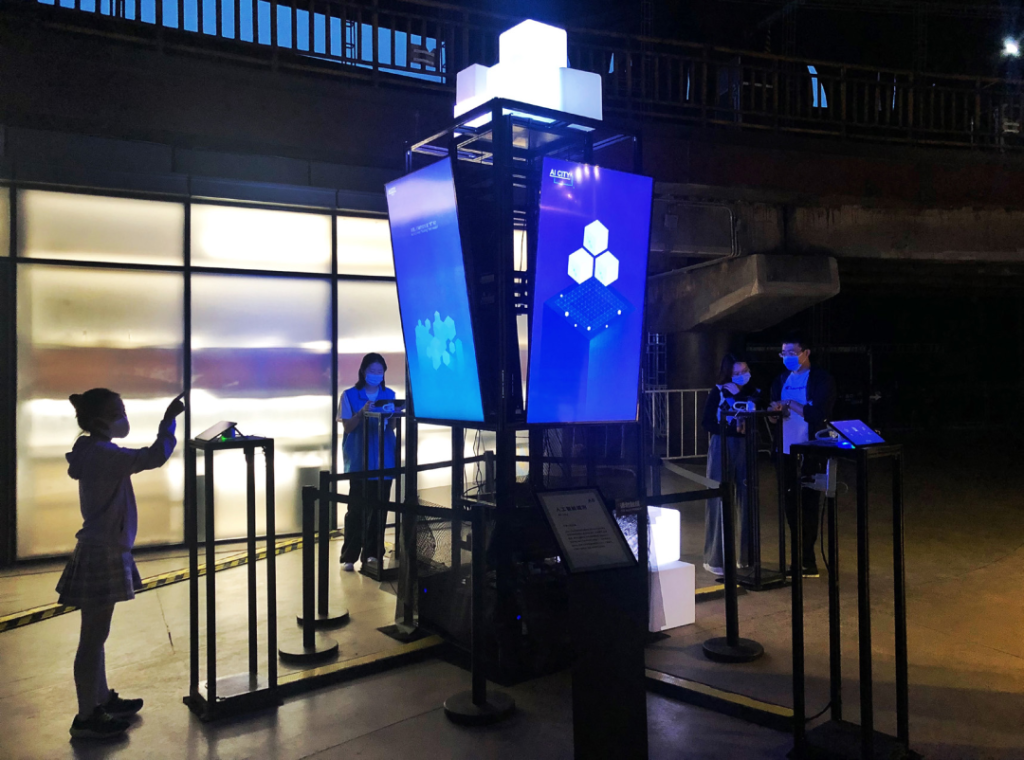
OPPO - 5G "Mirror - Boundary" Technology and Art Concept Exhibition
- AI City 2.5 - A-TOPIA -
A-TOPIA is a version of AlCity 2.5 work born during the COVID-19 outbreak, which evolved into an interactive story for mobile. The graduate student team used the core of the existing story, adding guided stories and a new visual style that is easier to spread in the digital world. There are different dimensions in the vast universe, and each dimension is a different world. It is hard for species in lower dimensions to imagine that a certain high-dimensional world, after a technological explosion, Al has developed into a super artificial intelligence, artificial intelligence and cities are deeply integrated, residents and technology have reached a symbiosis, and the traditional concept of the definition of space has been completely overturned. In the two-dimensional world, an advertising agency art director named Jason is able to enter the higher dimensional Al City - a digital utopia - while in a coma after a car accident, and the subsequent story links to the previous version of Al City.
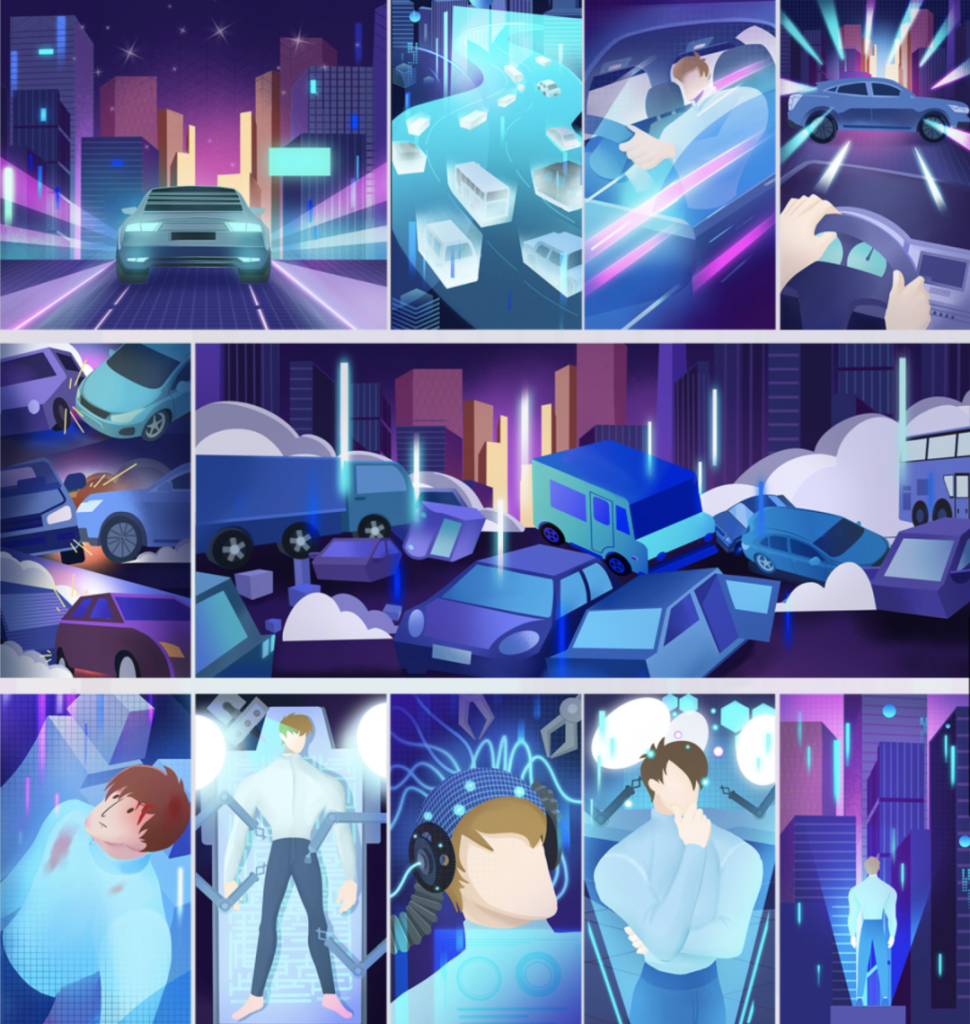
- AI City 3.0 -
The physical exhibition of AI City has ended, but the thinking never stops about the many scenarios in which AI will participate, share and control human life in the future. the era of AI is coming and triggers our foresight of Alternative futures, and will be the inflection point to promote human evolution. The potential of artificial intelligence is also infinite, and our interaction with it has just begun. A meta-universe triggered by AI City is emerging, can we wander in that world in the present and use augmented reality and interactive images to create a city of the future in our minds, can we use discursive stories to create a possible city that will resonate with us emotionally in an era of AI technology explosion. impact on the future of urban living, mobility, learning and health, but also a virtual creation tool and research platform to study the symbiosis of AI and human interaction. In this new iteration, virtual reality and mixed reality technologies will be introduced, and data and interaction will be the basis of this meta-universe, leading us to a multi-dimensional three-dimensional space-time that will inspire us to plan and design a more consensual urban future.
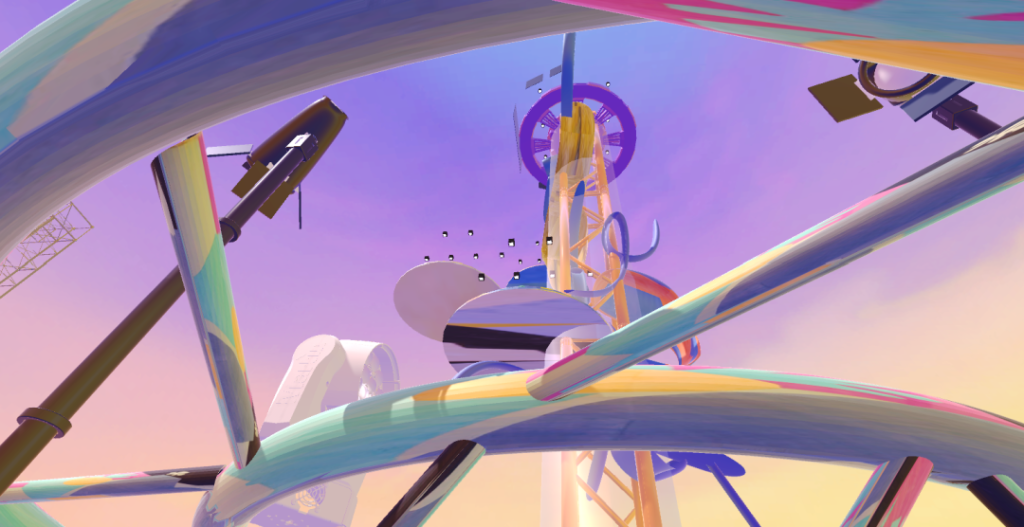
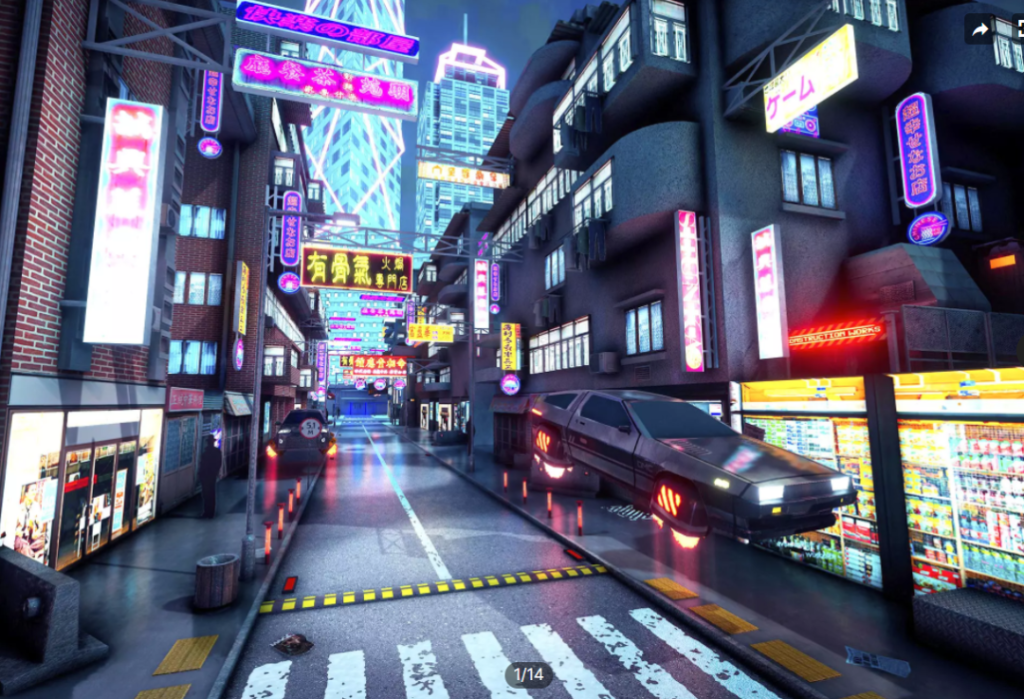
03 Projects Introduction
- AI City 4.0 -
AI City 4.0 is led by the Design Future Group at Tsinghua University's Academy of Fine Arts, and the AI City project generation mechanism extrapolates to an innovative extension of the metaverse world-building paradigm. This version will be further developed iteratively to the creation tools and open source platform to support more designers to participate in scenario development and future foresight. The scenario construction envisioned by the project will be built using any combination of design fictions asA narrative form of reflective dialogue between creator and artificial intelligence.
At the same time, the project will alsoFor the first time, AI generation technology is the leading technologyThe project will try to explore and create a series of distributed narrative spaces that integrate reality and virtual, presenting generative alternatives with behavioral data collection and multiple scenario selection to form a continuous, differentiated, distributed, egalitarian, and generative construction model through a symbiotic perspective of virtual and reality integration to reconstruct the relationship between users, objects, and scene elements. This distributed form of narrative space can not only help users migrate to the virtual world and present the impact of AI on the future life, mobility, learning and health of the city, but also further promote and study the virtual creation tools and research platforms for AI and human interaction and symbiosis. This new iteration will lead us to investigate the new sensory experience of distributed narrative spaces, where creators co-create AI City in the real world while AI City explores the shape of the future social landscape, inspiring us to plan and design a more agreeable urban future.
04 Job Description Responsibilities
Phase I Work.
- Use of discursive objects from the Innovation-New Infrastructure Tool Library as base data input.
- Text iteration and visual representation using AI platforms such as ChatGPT and Midjourney.
- Use the extrapolation process as an interview to collect and analyze members' feedback and ideas.
Phase II Work.
- Scene construction: collect, build, and adjust the models of objects under each city theme board, the appearance of the world hierarchy, the arrangement of space forms, the construction of basic objects, and the optimization of later models.
- Digital image: design and create digital character images under the theme board, such as bone binding, expression-driven production.
- Visual design: interface, information content presentation design.
- Technical development: Proficiency in using Unity and other software to achieve specific interactive functions according to project requirements.
05 Recruiting requirements Qualifications
(i) Content performance.
- Those who are interested in narrative space, artificial intelligence and the future of design and have a continuous interest in the field
- Proficiency in Ps, Ai, Ae, Pr and other Adobe software and strong graphic visual performance skills
- Practitioners from digital art, environmental design, architectural design and other related backgrounds
- Website building, game production and other related designers
(ii) Three-dimensional modeling.
- Strong modeling skills in software tools such as C4D, Blender, etc. (Previous involvement and experience in game development, web design, parametric art modeling preferred)
(iii) Programming development.
- Strong programming skills, such as familiarity with Unity, unreal and other game engines, and Chatgpt, Midjourney and other AI generation platforms, computer, new media artists, etc.
*The project cycle is expected to last until the end of April, with a cycle of 2 natural months. We invite partners who have relatively ample discretionary time, can participate in team meetings online and complete the work assigned by the team to join our team.
06 Number of recruits Recruit Number
3-5 people
* Preference will be given to applicants with a master's degree or higher and a background of overseas study and previous (current) study in a related field
07 Recruiting method Application Method
If you would like to participate in the project, you can scan the QR code below to register and enter your information. Please make sure to upload your relevant portfolio (max 20M) in the last column of the application form so that we can view it.Application deadline is 12:00 noon on February 16For those who have passed the resume screening, we will contact you via WeChat after the recruitment deadline, please check the WeChat message on the day of the deadline. If you do not pass the resume screening, no additional notification will be made.
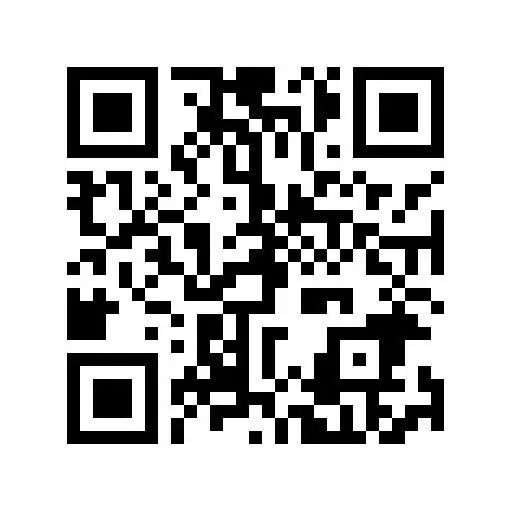
08 Project Harvest Acquisitions
- Internship Certificate: Team members will receive an internship certificate.
- Exhibiting experience: Team members will participate in various exhibitions as project members.
- Domain knowledge: Team members will gain an in-depth understanding of the concepts and ideas related to the Design Futures domain. On the basis of this knowledge, the team members will be able to grasp the practical paths and results of the Design Future tools and methods in the specific domain.
- International Friendship and Collaboration: Team members will have the opportunity to collaborate and interact with members from different academic backgrounds around the world.
- A certain internship allowance.

